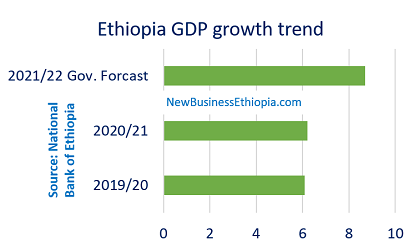The Government of Ethiopia forecasted 8.7 percent economic growth for the current Ethiopia’s budget year started July 8, 2021.
This is indicated in the annual economic report of the central bank of Ethiopia (National Bank of Ethiopia), which released its latest report this week. “The growth of the Ethiopian economy is projected at 8.7 percent in 2021/22 (July 8, 2021 – July 7, 2022) compared to 4.9 percent growth forecast for the world and 3.8 percent for Sub Saharan Africa economies,” the report stated.
The economy of Ethiopia has grown by 6.3 percent last budget year concluded July7, 2021, according to the report. The growth was broad based with industry growing at 7.3 percent, service 6.3 percent, and agriculture sector 5.6 percent, according to the report.
As a result, the share of industry in GDP increased slightly to 29.3 percent from 29 percent a year ago (2010/20). In contrast the share of agriculture to GDP dropped marginally to 32.5 percent from 32.7 percent over the same period.
“This reflects a gradual but steady shift in the structure of the economy towards developing manufacturing sector and promoting export-led growth…” said Governor of the National Bank of Ethiopia (NBE) Yinager Dessie (PhD) whose note/comment is attached to the annual report.
He stated that due attention will continue to be given to modernize agriculture, which has been dominating Ethiopian economy for many decades in terms of job creation, generation of hard currency, and currency generation, among others.
Agriculture
In 2020/21, total grain production amounted to 341.8 million quintals depicting a 2 percent annual increment. Of the total crop production was cereal production, 9.4 percent pulses and 2.3 percent oil seeds.
Cereals and pulses production increased by 1.8 and 6.5 percent partly on account of 0.6 and 7.1 percent expansion in cultivated land areas, respectively.
“However, the production of oilseeds showed 7.7 percent contraction owing to 6.6 percent a decline in cultivated land area,” the annual report stated.
It also indicated that the total land cultivated area for crop production reached 13.0 million hectares, of which cereals production accounted for 81.2 percent, pulses 12.9 percent and oil seeds 5.9 percent.
Top service sector growth drivers
When it comes to the 6.3 percent service sector growth registered last year, it was largely attributed to the expansion of real estate, renting and; business activities (8.9 percent), transport and; communication (7.0 percent), wholesale and; retail trade (6.3 percent), other services (6.2 percent), public administration and; defense (4.9 percent) and hotels and; restaurants (2.6 percent), according to the annual report.
Industry
With 5.1 percent growth, the manufacturing accounted for 23.4 percent of the industrial output, according to the annual report.
“Construction industry registered 6.6 percent expansion with 72.2 percent share in industrial output, with roads, railways, dams and residential houses construction, playing a significant role.”
Mining
It also stated that “the growth momentum in mining and quarrying sector continued in 2020/21 and saw a 115.4 percent expansion partly due to the conducive policy measures taken by NBE to incentivize the miners to opt for more formal marketing channels”.
“Yet, its contribution to industrial production is still minimal (1.8 percent). Meanwhile, electricity & water had a 2.7 percent share in industrial production,” the annual report stated.
The annual report also indicated that nominal GDP per capita stood at USD 1,092, depicting a 1.1 percent marginal improvement relative to the previous year. Ethiopia’s GDP growth for the previous year 2019/20, was 6.1 percent, according to NBE.
